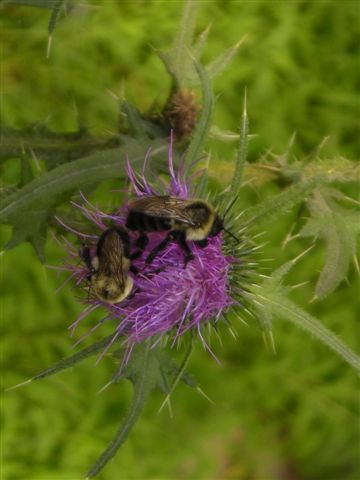Martie Young
Adams County Master Gardener
 Bees are the new 'big topic' in the gardening world. What would we do without them? What would we eat? How would we get honey? Gardeners, farmers, orchardists, and scientists are all doing their best to answer these questions, and also
to help the bee population survive and thrive. We live on a planet pollinated primarily by bees. Bees pollinate most of our favorite flowers and one third of the plants we eat.
Bees are the new 'big topic' in the gardening world. What would we do without them? What would we eat? How would we get honey? Gardeners, farmers, orchardists, and scientists are all doing their best to answer these questions, and also
to help the bee population survive and thrive. We live on a planet pollinated primarily by bees. Bees pollinate most of our favorite flowers and one third of the plants we eat.
Honey Bees:
I realize I am a gardener and so I hear a lot about the bee problem, but there may still be some people out there who haven't heard about Colony Collapse Disorder destroying hives around the world. Some may still consider a bee an insect to fear or to kill. Even one of our U.S. senators (who shall
go unnamed) said that insurance for honey bees is a 'pork project' and should be eliminated from the stimulus package. Of all the items that might be considered 'pork' we probably need honey bees more than anything else. Honey bees are the major pollinators of apples, pears, cherries, and plums. These trees were staples on
the small farms that used to surround our towns.
Things are quite different now-our landscape has been broken up into developments with nary a tree-at least not one that bees are attracted to. The orchards are certainly still here, but bigger. Today honeybees are rented and their hives are transported by trucks to the fruit and vegetables as they
are needed. Maybe this is part of the problem. Who doesn't get stressed on the interstate, traveling along in rush hour or very hot or cold conditions!
 To answer the question of what would we eat if honey bees disappeared, the only items left to us would be grains and cereal. Corn and cereal grains are pollinated by wind. That is why the corn seed package will say to plant your corn in a block, not a single long row. You can identify a corn ear
that has been incompletely pollinated because the kernels are uneven in size or the kernels only go halfway up the ear. Wheat, oats, and barley all have the seed heads at the tops of the stems-the breeze blows and the plants get pollinated. Concerning honey, we wouldn't have any without bees-only honey bees make honey, a
product that doesn't spoil (it has been found in the pyramids in Egypt). This is certainly a simplification-in the hive the bees seal the honey compartments; in the grocery store the jar is sealed. But once the jar is opened the honey may turn sugary, but not spoiled.
To answer the question of what would we eat if honey bees disappeared, the only items left to us would be grains and cereal. Corn and cereal grains are pollinated by wind. That is why the corn seed package will say to plant your corn in a block, not a single long row. You can identify a corn ear
that has been incompletely pollinated because the kernels are uneven in size or the kernels only go halfway up the ear. Wheat, oats, and barley all have the seed heads at the tops of the stems-the breeze blows and the plants get pollinated. Concerning honey, we wouldn't have any without bees-only honey bees make honey, a
product that doesn't spoil (it has been found in the pyramids in Egypt). This is certainly a simplification-in the hive the bees seal the honey compartments; in the grocery store the jar is sealed. But once the jar is opened the honey may turn sugary, but not spoiled.
Another Social Bee:
Honey bees are social-they have a hive, a queen, workers and drones-all with specific tasks. Bumblebees are also social and live in a group. With our landscaped lawns and non-native shrubs as landscaping, they may find it difficult to find shelter or food. Bumblebees will live in old mouse nests or
rodent burrows, deserted bird nests, cushioned clumps of moss and simple holes in the ground. Be sure to leave some bare patches of earth available to bees and other ground-dwelling insects.
Bumblebees are important pollinators of tomatoes, eggplants, peppers, melons, raspberries, blueberries, cranberries, strawberries, and many other crops. They are the only known pollinators of potatoes worldwide. They are also the exclusive pollinator of several rare and imperiled wildflowers,
including native monkshoods and lady's tresses orchids. Without these essential insects, farm productivity would plummet and some wildflowers would become extinct. In short, bumblebees and other bees are essential for our own well being and the survival of a good deal of the world's biodiversity. Another little-known fact
is that bumblebees will pollinate the tomato plants that are grown in greenhouses; they work side by side with the human workers, without stinging.
Solitary Bees:
There are many other native American bees. For the most part these are solitary bees, meaning they do not congregate in a hive or have a queen or make honey. They lay their eggs in a hollow flower stem, or a hole made in a tree by a bird or insect, or they may live in the soil. They can make use of
the many bee boxes that are now available to the general public to promote bee habitation. These solitary bees do pollinate native plants. Don't jump to the conclusion when you see a bee on a flower that it is a honey bee. Mason bees, carpenter bees and orchard bees are all examples of solitary bees.The natural habitats of
bumblebees and other native bees, which were pollinating North America long before the colonists arrived with their European honeybees, continue to be carved up, destroyed, or degraded. However, we all can help improve the lot of natives by planting the flowers they love, whether we garden on an acre or in a window box.
One small bumblebee garden may not seem like much, but as these patches of backyard habitat multiply across the community and the country, they can play a vital role in feeding and protecting threatened pollinators.
Other Pollinators:
There are many other pollinators-birds, bats, insects, flies, moths and small animals such as mice. If your yard has desirable plants, the pollinators will show up and we will be richer for them.
There are some internet sites where you can learn more about bees. For the Xerces Society, visit www.xerces.org. For the North American Pollinator Protection Campaign, visit www.nappc.org. Or for the U.S. Forest Service Pollinator website, try www.fs.fed.us/wildflowers/pollinators/index.shtml.